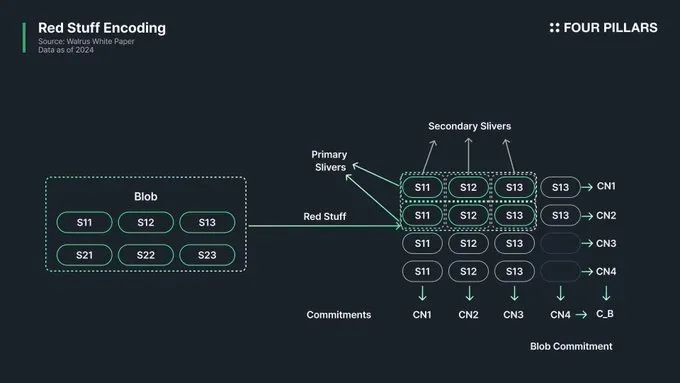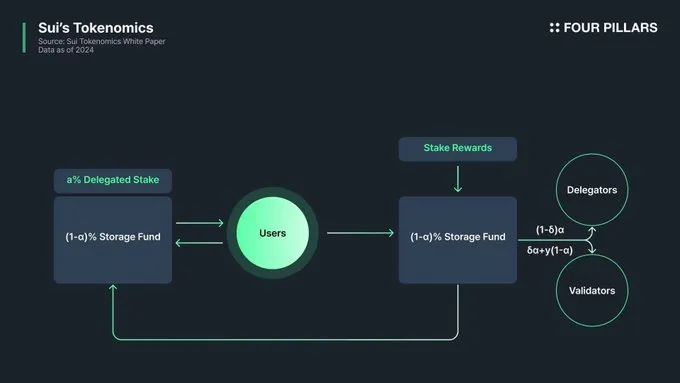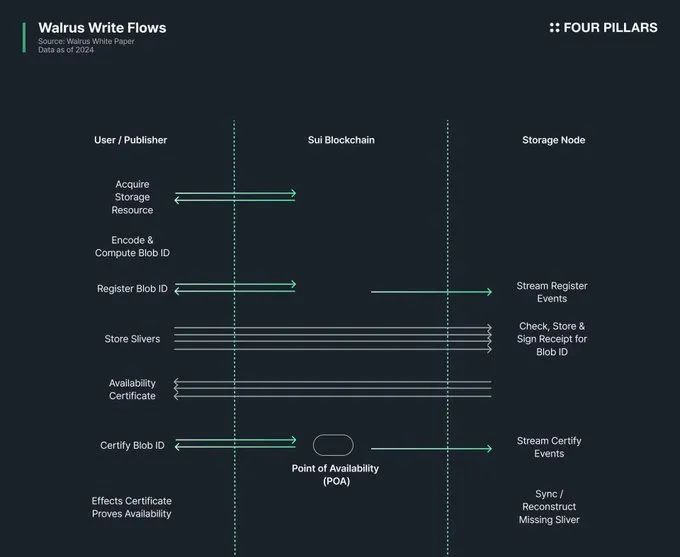Author of this article: @Steve_4P, the article only represents the author's views.
Key Points Summary
Mysten Labs has successfully launched the Sui network and the DeepBook protocol, and is now preparing to launch a new project—the Walrus protocol.
Although there are many protocols in the decentralized storage market, Walrus has attracted widespread attention for two reasons: (1) Cost-effectiveness and security: Walrus is more cost-effective and secure than existing storage solutions. (2) Programmability: It allows the stored data to be programmed through the Sui network.
As one of the most advanced projects among existing decentralized storage protocols, Walrus is worth paying attention to for its future practicality and value.
01 Background of Walrus Launch
Mysten Labs has successfully launched the Sui network and the DeepBook protocol, and is now venturing into a new area—the Walrus protocol. The success of Sui and DeepBook has generated a lot of anticipation for the Walrus project. However, despite the high enthusiasm, there are also some concerns surrounding the Walrus protocol.
These concerns stem from several factors: there are already many decentralized storage solutions on the market, many of which have not achieved ideal performance; and there are worries about resource allocation—especially whether Mysten Labs will divert resources to continue developing and expanding the Sui network, affecting the progress of the new project.
Therefore, we will explore the structure of the Walrus protocol, analyze how it differs from existing decentralized storage solutions, and further investigate the relationship between Walrus and the Sui network, focusing on how Walrus integrates with the Sui architecture and enhances the overall value of the Sui ecosystem.
1. Differences Between Walrus and Existing Storage Solutions
To illustrate why Walrus needs to exist, we first need to discuss how it differs from existing decentralized distributed storage solutions. From my perspective, there are three main differences between Walrus and existing storage models (especially Filecoin and Arweave), which can be summarized as follows:
Storage Cost Efficiency

First, there are significant differences in storage costs between Walrus, Arweave, and Filecoin. As discussed in the Walrus article by Four Pillars, Arweave employs a system where all nodes must replicate and store all data, while Filecoin allows users to decide how many nodes store their data (users can choose to store data with just one miner or distribute 100 copies of data across 100 miners. Clearly, the more miners required to store the data, the higher the cost).
In contrast, Walrus uses Red-Stuff encoding, demonstrating lower costs than Arweave and Filecoin, with efficiencies up to 100 times greater (compared to Arweave, which requires full network data storage, leading to a maximum of 500 times replication costs, while Walrus only requires 4-5 times replication). At the same time, the probability of data loss is significantly reduced.
In simple terms, Walrus addresses the shortcomings of Arweave and Filecoin. While Arweave has a low probability of data loss, it has high replication costs; Filecoin offers relatively cheap storage based on user demand, but low-cost options may come with higher risks of data loss; Walrus combines the advantages of both by maintaining low replication costs while minimizing the probability of data loss.
Additionally, for Arweave, costs increase with the number of nodes (though not linearly), as it encourages all nodes/specified nodes to store as much complete data as possible. In contrast, Walrus only requires a single network data transfer, with each node storing a portion of the data, which effectively alleviates the burden on each node as the network grows. This structural difference makes Walrus's storage costs significantly more efficient than those of Arweave and Filecoin.
Programmability
While the efficiency of Walrus compared to Arweave and Filecoin is very important, its most significant distinction from existing storage models is "programmability." Traditional storage is merely a simple data repository, while Walrus achieves programmable decentralized storage through the Sui network, endowing stored data with more functionality.
What if smart contracts could directly reference or trigger data stored in decentralized storage? For example, when minting an NFT, the image file can be stored in Walrus, and its blob data object can be created on the Sui network, linking it to the NFT object. This resolves the traditional NFT "incompleteness" issue (traditional NFTs store tokens on-chain, but the artistic metadata of the NFT is stored off-chain), making NFTs through Walrus true Web3 assets.
Another example directly related to data storage is that, since the blob data of Walrus can be stored as Sui objects and controlled through Sui's Move smart contracts, smart contracts can transfer stored data to other users or automatically change ownership. This is why we say that the data in Walrus is programmable.
In contrast, Arweave and Filecoin have very limited, if not nearly impossible, dynamic integration with on-chain applications. While Filecoin has added some smart contract functionality through FVM (Filecoin Virtual Machine), the ability to modify and control data remains limited, with Walrus clearly outperforming these two protocols in terms of programmability.
Data Access and Deletion
Existing storage protocols have a characteristic: once data is uploaded, it can be accessed by anyone and cannot be deleted. While this feature may be useful for individual users, it poses significant limitations for institutions and enterprises that need to store sensitive data or require modification/deletion of data. In contrast, Walrus allows users to discard or modify their data when needed (this differs from Arweave, where data cannot be deleted or modified; and from Filecoin, where data deletion is not user-initiated but occurs when contracts expire or the nodes hosting the data go offline).
Some may worry that this conflicts with the principle of immutability in blockchain, but it is important to remember that in Walrus, what is deleted is blob data. Transaction data unrelated to blob data remains unchanged, and deleting blob data does not affect the integrity of the blockchain.
Compared to traditional storage, this enhanced practicality of Walrus greatly increases its application potential in traditional enterprises and Web2 companies, further raising market expectations for its diversity.
2. How Walrus Collaborates with the Sui Network
After discussing the differences between Walrus and existing storage protocols, let’s explore the relationship between Walrus and the Sui network. When Mysten Labs announced the preparation for the Walrus protocol, many expressed skepticism, believing that "they should focus on Sui rather than create a new protocol." However, with a slight understanding of how Walrus operates, it becomes clear that Walrus does not detract from the focus on Sui; rather, it should be seen as a storage stack aimed at enhancing applications on Sui. In other words, Walrus not only complements the Sui network from a storage perspective but also actively influences the governance token SUI of the Sui network, making the two inseparable. We will further explore this next.
Symbiotic Relationship Between Sui and Walrus
In fact, Mysten Labs was very focused on storage issues during the early design phase of Sui. The blockchain inevitably grows during use, which may lead to increased transaction fees for future Sui network users. Therefore, from the early design phase of Sui, Mysten Labs proposed a unique storage fund concept to address Sui's storage challenges.

The operation of the Sui storage fund is as follows: the fees submitted by users to Sui validation nodes are divided into two parts: 1) Gas fees related to computation, and 2) storage fees for data storage. Sui collects storage fees in advance when users upload data and pools these funds into the storage fund. The storage fund continuously allocates these funds to validation nodes as long as the data remains stored on-chain. Additionally, if users delete data, they can receive a refund of the storage fees.
Sui's unique on-chain data storage system produces two effects:
- Users can receive a refund of storage fees when deleting on-chain data, creating an economic incentive to reduce the capacity of the distributed ledger.
- The system addresses sustainability issues related to storage by collecting storage fees in advance and using them as rewards for future validation nodes.
Although Sui addresses sustainability issues through this unique structure, storing large-scale blob data (such as media files) on-chain remains a burden. This is where Walrus comes into play—by storing large-scale blob data through Walrus and managing its metadata as objects on Sui, data can achieve programmability without being directly stored on Sui.

Furthermore, Walrus achieves the most distinctive feature compared to other storage protocols through Sui—making stored data programmable and controllable. Ultimately, a symbiotic relationship is established between Sui and Walrus, with both complementing each other's shortcomings and creating unique advantages.
Walrus Makes SUI a Deflationary Asset
From the example of the storage fund, we can see that the Sui network requires a certain amount of SUI to be paid as storage fees for storing any object, and Walrus is no exception. When a blob data object is created in Walrus, SUI will be locked in the storage fund based on the size of the object (referring to the size of the object representing the blob, not the actual size of the blob).
Although part of the fee can be refunded by deleting data, a portion of the fee will have a destruction effect, reducing circulation by permanently removing tokens. In other words, the more data stored through Walrus, the more SUI will be permanently locked in the storage fund, creating a virtuous cycle where increased use of Walrus leads to a decrease in SUI circulation.
In summary, the emergence of Walrus is positive news for the Sui network, both from a network perspective and an asset perspective. It is expected that through Walrus, the Sui ecosystem will develop in a more diversified direction.
02 Walrus Will Become the Most Critical Protocol for Sui
1. Not Just Building a Blockchain
When Mysten Labs was first established, I thought it was just a company focused on the Sui network. However, after seeing the launch of services like Deepbook and SuiNS, I began to ponder what kind of vision Mysten Labs was pursuing. When I encountered Walrus, I realized that their goal is to build a complete decentralized infrastructure for Web3.
Compared to other companies, Mysten Labs has a different time horizon when viewing this industry. They are not just issuing tokens, creating hype, and quickly monetizing; rather, they have a vision to lead innovation in various areas such as execution, storage, consensus, and communication, while understanding users' inertia towards Web2 services and creating the most suitable UI for them.
The Sui network handles execution and consensus (continuously evolving through programs like Mysticeti, Pilotfish, and Remora), storage is managed by Walrus, and communication is handled by SCION (a next-generation internet architecture capable of protecting network packets, known for its DDoS protection and immunity to routing attacks—it's important to note that SCION is not created by Mysten Labs, but it will be applied to the Sui network), while the Web2 familiar UI is managed by zkLogin, Stashed, SEAL, and KELP.
If these plans can be successfully implemented, I believe Mysten Labs can rewrite the existing Web3 paradigm. My initial thoughts were limited; Mysten Labs is not just trying to build a blockchain—they are a team building infrastructure for a new network. Of course, I believe Sui is at the core of Mysten Labs' vision, with other plans playing complementary roles. Walrus is no exception; in my view, Walrus may be the most important protocol among them.
2. Walrus Is Not Limited to the Sui Ecosystem
However, Walrus is not limited to the Sui ecosystem. Like other storage protocols, Walrus can be used by any third party, not just Sui applications; it may even serve as a strong alternative to existing storage protocols or as an alternative for other DA layers (such as Celestia, EigenDA, Avail).
This availability of Walrus will extend the demand for SUI beyond the Sui network. When Walrus is used, data objects will be created on the Sui network, leading to a decrease in SUI circulation. In other words, Walrus has the potential to make SUI a more attractive asset by creating external demand (this is not investment advice, but a structurally possible scenario). Therefore, Walrus is expected to become a bridge, expanding in various directions for Sui.
3. Can Walrus Surpass Filecoin?
While caution is needed when comparing the value of specific protocols, I am very optimistic about the future of Walrus because: 1) its operational mechanism is far more efficient than existing storage protocols, 2) it can perform tasks that existing storage protocols cannot accomplish (such as becoming DA or making stored data programmable), and 3) it already has a solid network and user base through the Sui network.
If Walrus is not just the storage layer of the Sui network, but becomes the representative storage protocol for Web3 as envisioned by Mysten Labs, it has the potential to become the leading protocol in the storage field.
免责声明:本文章仅代表作者个人观点,不代表本平台的立场和观点。本文章仅供信息分享,不构成对任何人的任何投资建议。用户与作者之间的任何争议,与本平台无关。如网页中刊载的文章或图片涉及侵权,请提供相关的权利证明和身份证明发送邮件到support@aicoin.com,本平台相关工作人员将会进行核查。




